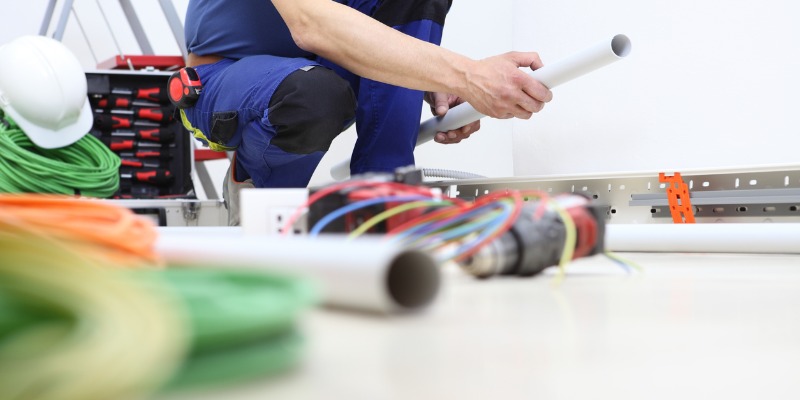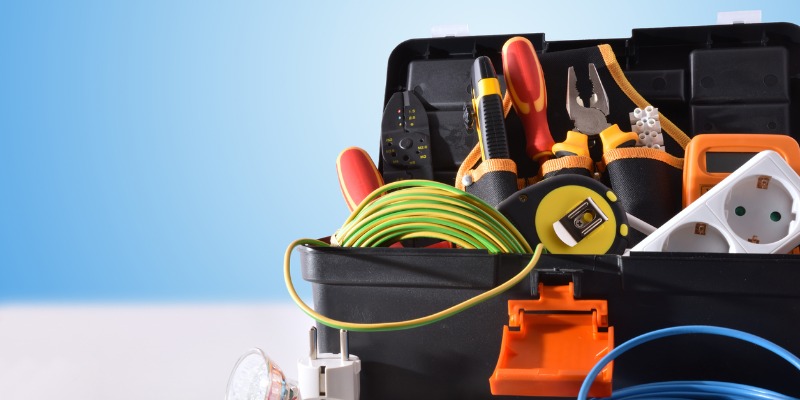
The method for installing transformer cable varies based on the type of project. The most common methods include pulling, blowing, and pushing into ducts, direct burial, and aerial installation. Here we offer a guide to transformer cable installation and recommended sizing.
Methods of Transformer Cable Installation
Common methods of installation include:
- Installation in ducts: Using this method, lightweight/rigid cables are installed by blowing while heavier cables are pulled.
- Installation in covered ducts or troughs: This method is used for a larger number of cables installed in ducts or troughs. Deflector rollers help reduce friction.
- Installation via direct burial: As the name implies direct burial applies to underground cables that have stronger sheath designs than those used for ducts. Trenches are dug and the cables are buried. The stronger sheath design protects cables against crushing and impact not to mention issues such as rodents to chemicals.
The method used is based on the type of cable, its application, and location.
Transformer Cable Installation
Here are some general guidelines for transformer cable installation, regardless of the cable type and installation method used:
- Keep drums in an upright position during installation as well as transportation.
- Perform an inspection of both cables and drums, especially if the packaging is damaged or appears loose or the labelling on the packaging is damaged or unclear. While damage can occur to any aspect of the drums or cables, some more common issues include:
- Drums on the flange or dropped in transportation might have slipped cable windings
- Loose or rotting drums that could break down during payoff
- Drum screws that need tightening
- Water damage if cable end seals are missing or appear damaged
- Signs nails or clamps pierced the flange
- Loose nails of the flange must be removed so they can’t damage the cable sheath
- Release the inner end of the cable from the flange before it is unreeled.
- Always check the cable prior to installation to ensure it is within the permissible temperature range based on the following minimums:
- Cable with PVC sheath: – 5 °C
- Cable with oil-resistant PVC sheath: + 5 °C
- ICON®Arctic Cable with FRILON PVC sheath (optimized for low temperatures): – 30 °C
- Cable with PE or XLPE insulation and PE sheath: – 20 °C
- If the temperature is too low, the cable must be preheated to the proper temperature before it can be installed.
- You must ensure the maximum tensile force isn’t exceeded during installation using installation equipment that allows for online tensile force measurement. An emergency stop must also be used to automatically stop the process if the maximum force is exceeded.
- Cables can’t be bent around radii smaller than the ones specified, nor can the rollers. Sheaves and sheave assemblies have smaller bending radii based on specifications for the minimum radii for the cable used. Some common diameters include:
- Cable without armoring and lead cover: 7.5 x overall cable diameter
- Cable with armoring: 10 x overall cable diameter
- Cable with lead cover: 15 x overall cable diameter
- To determine the radius for rollers, measure the distance between the wheel tread and the central axle.
- When being installed, the curvatures must be smooth, and you should avoid bending the cable too much, turn-backs and sharp changes of direction.
These basics work for all methods. Appropriate steps must be applied based on the method used. For example, fiber optic cables are usually installed by pulling or blowing. Need help with cable installation and learning more about cable sizing? Look no further. VCM Solutions can provide you with more information. Contact us today.
Sizing Guide
Base sizing on whether the cables are buried or unburied. Here are the most common configurations for each.
Unburied Cables
| Reference methods | Number of loaded conductors and type of insulation | |||||||||||
| A1 | 2 PVC | 3 PVC | 3 XLPE | 2 XLPE | ||||||||
| A2 | 3 PVC | 2 PVC | 3 XLPE | 2 XLPE | ||||||||
| B1 | 3 PVC | 2 PVC | 3 XLPE | 2 XLPE | ||||||||
| B2 | 3 PVC | 2 PVC | 3 XLPE | 2 XLPE | ||||||||
| C | 3 PVC | 2 PVC | 3 XLPE | 2 XLPE | ||||||||
| E | 3 PVC | 2 PVC | 3 XLPE | 2 XLPE | ||||||||
| F | 3 PVC | 2 PVC | 3XLPE | 2 XLPE | ||||||||
| 1 | 2 | 3 | 4 | 5 | 6 | 7 | 8 | 9 | 10 | 11 | 12 | 13 |
| Size (mm2) | ||||||||||||
| Copper | ||||||||||||
| 1.5 | 13 | 13.5 | 14.5 | 15.5 | 17 | 18.5 | 19.5 | 22 | 23 | 24 | 26 | – |
| 2.5 | 17.5 | 18 | 19.5 | 21 | 23 | 25 | 27 | 30 | 31 | 33 | 36 | – |
| 4 | 23 | 24 | 26 | 28 | 31 | 34 | 36 | 40 | 42 | 45 | 49 | – |
| 6 | 29 | 31 | 34 | 36 | 40 | 43 | 46 | 51 | 54 | 58 | 63 | – |
| 10 | 39 | 42 | 46 | 50 | 54 | 60 | 63 | 70 | 75 | 80 | 86 | – |
| 16 | 52 | 56 | 61 | 68 | 73 | 80 | 85 | 94 | 100 | 107 | 115 | – |
| 25 | 68 | 73 | 80 | 89 | 95 | 101 | 110 | 119 | 127 | 135 | 149 | 161 |
| 35 | – | – | – | 110 | 117 | 126 | 137 | 147 | 158 | 169 | 185 | 200 |
| 50 | – | – | – | 134 | 141 | 153 | 167 | 179 | 192 | 207 | 225 | 242 |
| 70 | – | – | – | 171 | 179 | 196 | 213 | 229 | 246 | 268 | 289 | 310 |
| 95 | – | – | – | 207 | 216 | 238 | 258 | 278 | 298 | 328 | 352 | 377 |
| 120 | – | – | – | 239 | 249 | 276 | 299 | 322 | 346 | 382 | 410 | 437 |
| 150 | – | – | – | – | 285 | 318 | 344 | 371 | 395 | 441 | 473 | 504 |
| 185 | – | – | – | – | 324 | 362 | 392 | 424 | 450 | 506 | 542 | 575 |
| 240 | – | – | – | – | 380 | 424 | 461 | 500 | 538 | 599 | 641 | 679 |
| Aluminum | ||||||||||||
| 2.5 | 13.5 | 14 | 15 | 16.5 | 18.5 | 19.5 | 21 | 23 | 24 | 26 | 28 | – |
| 4 | 17.5 | 18.5 | 20 | 22 | 25 | 26 | 28 | 31 | 32 | 35 | 38 | – |
| 6 | 23 | 24 | 26 | 28 | 32 | 33 | 36 | 39 | 42 | 45 | 49 | – |
| 10 | 31 | 32 | 36 | 39 | 44 | 46 | 49 | 54 | 58 | 62 | 67 | – |
| 16 | 41 | 43 | 48 | 53 | 58 | 61 | 66 | 73 | 77 | 84 | 91 | – |
| 25 | 53 | 57 | 63 | 70 | 73 | 78 | 83 | 90 | 97 | 101 | 108 | 121 |
| 35 | – | – | – | 86 | 90 | 96 | 103 | 112 | 120 | 126 | 135 | 150 |
Buried Cables
| Installation method | Size mm2 | Number of loaded conductors and type of insulation | |||
| Two PVC | Three PVC | Two XLPE | Three XLPE | ||
| D1/D2 | Copper | ||||
| 1.5 | 22 | 18 | 26 | 22 | |
| 2.5 | 29 | 24 | 34 | 29 | |
| 4 | 38 | 31 | 44 | 37 | |
| 6 | 47 | 39 | 56 | 46 | |
| 10 | 63 | 52 | 73 | 61 | |
| 16 | 81 | 67 | 95 | 79 | |
| 25 | 104 | 86 | 121 | 101 | |
| 35 | 125 | 103 | 146 | 122 | |
| 50 | 148 | 122 | 173 | 144 | |
| 70 | 183 | 151 | 213 | 178 | |
| 95 | 216 | 179 | 252 | 211 | |
| 120 | 246 | 203 | 287 | 240 | |
| 150 | 278 | 230 | 324 | 271 | |
| 185 | 312 | 258 | 363 | 304 | |
| 240 | 361 | 297 | 419 | 351 | |
| 300 | 408 | 336 | 474 | 396 | |
| D1/D2 | Aluminum | ||||
| 2.5 | 22 | 18.5 | 26 | 22 | |
| 4 | 29 | 24 | 34 | 29 | |
| 6 | 36 | 30 | 42 | 36 | |
| 10 | 48 | 40 | 56 | 47 | |
| 16 | 62 | 52 | 73 | 61 | |
| 25 | 80 | 66 | 93 | 78 | |
| 35 | 96 | 80 | 112 | 94 | |
| 50 | 113 | 94 | 132 | 112 | |
| 70 | 140 | 117 | 163 | 138 | |
| 95 | 166 | 138 | 193 | 164 | |
| 120 | 189 | 157 | 220 | 186 | |
| 150 | 213 | 178 | 249 | 210 | |
| 185 | 240 | 200 | 279 | 236 | |
| 240 | 277 | 230 | 322 | 272 | |
| 300 | 313 | 260 | 364 | 308 | |
Need help with cable installation or want to learn more about cables? Contact our experts at VCM Solutions to learn more.
Sources:
https://publications.leoni.com/fileadmin/process_industry/publications/instructions_guidelines/guidelines_cable_installation.pdf?1498213963 https://www.electrical-installation.org/enwiki/Recommended_simplified_approach_for_cable_sizing